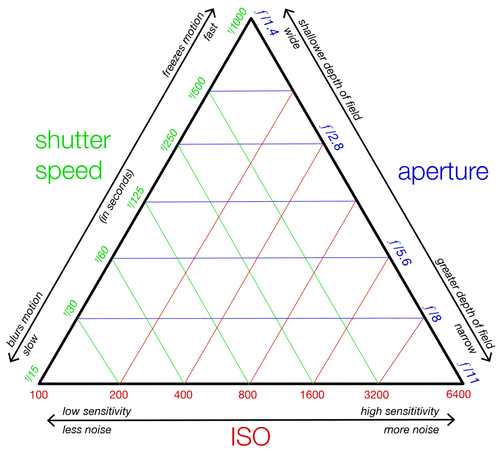Understanding the concept of ISO and ASA is akin to unlocking a crucial element of the art form of film photography.
The principles of ‘ISO speed’, ‘aperture’, and ‘exposure time’ have seamlessly transitioned into digital photography, albeit many modern devices, particularly smartphones, automatically adjust these settings.
While professionals and enthusiasts meticulously consider these parameters, many users prefer a simpler approach, relying on digital filters or editing tools to achieve their desired effects, allowing for effortless point-and-shoot photography.
We explain the exposure triangle relating to ISO/ASA below our reader supported advertiser:
ASA (American Standards Association), also known as ISO (International Organization for Standardization) in modern terms, has played a pivotal role in shaping how photographers capture light and translate it into timeless images. Let’s take a journey back in time to explore the rich history and early years of ASA in film photography.
Origins of ASA:
The concept of ASA originated from the need for a standardized system to measure the sensitivity of photographic film to light. Before ASA, various manufacturers used their own proprietary systems, leading to confusion and inconsistency. In 1943, the American Standards Association introduced the ASA system, which provided a unified scale for film sensitivity ratings.
Understanding ASA:
ASA measures the film’s sensitivity to light, commonly referred to as film speed. A higher ASA rating indicates greater sensitivity to light, allowing for faster shutter speeds and/or smaller apertures in varying lighting conditions. Conversely, lower ASA ratings offer finer grain and greater detail but require longer exposures in low-light settings.
ASA Exposure Triangle
In this table, each row represents a different ISO/ASA setting, while each column shows the corresponding aperture and shutter speed combinations. These combinations are based on the exposure triangle principle, where adjustments in one parameter (ISO, aperture, or shutter speed) can be compensated by changes in one or both of the other parameters to maintain proper exposure.
| ISO/ASA | Aperture | Shutter Speed |
|---|---|---|
| 100 | f/8 | 1/125 sec |
| 200 | f/8 | 1/250 sec |
| 400 | f/8 | 1/500 sec |
| 800 | f/8 | 1/1000 sec |
| 1600 | f/8 | 1/2000 sec |
| 100 | f/5.6 | 1/250 sec |
| 200 | f/5.6 | 1/500 sec |
| 400 | f/5.6 | 1/1000 sec |
| 800 | f/5.6 | 1/2000 sec |
| 1600 | f/5.6 | 1/4000 sec |
| 100 | f/4 | 1/500 sec |
| 200 | f/4 | 1/1000 sec |
| 400 | f/4 | 1/2000 sec |
| 800 | f/4 | 1/4000 sec |
| 1600 | f/4 | 1/8000 sec |
Evolution of ASA:
In the early years, ASA ratings typically ranged from ASA 10 to ASA 1600, with each doubling representing a change in exposure by one f-stop. As technology advanced, film manufacturers developed faster films with higher ASA ratings, catering to diverse shooting conditions and artistic preferences.
Impact on Photography:
The introduction of ASA revolutionized photography by providing photographers with greater flexibility and creative control. Higher ASA films allowed for capturing fast-moving subjects or shooting in low-light environments without sacrificing image quality.
This newfound versatility expanded the possibilities for photographers, influencing their artistic decisions and visual storytelling.
Challenges and Innovations:
While higher ASA films offered enhanced sensitivity, they often came with trade-offs such as increased graininess and reduced dynamic range. Film manufacturers continuously innovated to address these challenges, developing new emulsions and processing techniques to improve image quality while maintaining higher ASA ratings.
Legacy of ASA:
Despite the transition to digital photography and the adoption of ISO as the standard measurement for film speed, the legacy of ASA continues to resonate with photographers worldwide.
The principles of sensitivity, exposure, and creative expression established during the early years of ASA remain foundational to the art and craft of photography.

The History and Early Years of ASA in Film Photography
The history and early years of ASA in film photography represent a journey of innovation, experimentation, and artistic exploration. From its humble origins to its profound impact on the photographic process, ASA has left an indelible mark on the world of visual storytelling.
As photographers continue to push the boundaries of creativity, they honor the legacy of ASA by embracing its principles and adapting them to the ever-evolving landscape of image-making.
ASA became ISO
Today, ISO (International Organization for Standardization) is more commonly used in the context of film sensitivity ratings, replacing the ASA (American Standards Association) scale. The primary difference between the two lies in their origins and standards bodies.
ASA was introduced by the American Standards Association in 1943 as a system for measuring the sensitivity of photographic film to light. This scale was widely adopted and became the de facto standard for film sensitivity ratings in the photography industry. However, as the photography world became more globalized with the internet, there arose a need for a unified international standard.
ISO, the International Organization for Standardization, stepped in to address this need. In 1974, ISO introduced its own film speed scale, which was based on the ASA system but expanded to encompass a broader range of film speeds.
ISO’s scale also incorporated the DIN (Deutsches Institut für Normung) system used in Europe, resulting in a unified international standard for film sensitivity ratings.
While both ASA and ISO scales measure the same concept of film sensitivity, ISO has become the predominant term used in modern photography. This is largely due to ISO’s status as an international standard recognized and adopted by photographers, manufacturers, and industry professionals worldwide. As a result, the term “ISO” is commonly used interchangeably with “film speed” or “sensitivity” in contemporary photography discussions.
Related stories
Master of Photography reading list
Exposure Triangle Principle in Photography Explained
The Phenomenon of Everyone’s a Photographer Now
Can I make money as a freelance photographer
The Rise of Smartphone Photography
Navigating the Future of Professional Photography
How Getty Images & Disruptors Changed Photography
National Institute of Dramatic Art (NIDA)
Guide to Collecting Vintage Film Cameras



